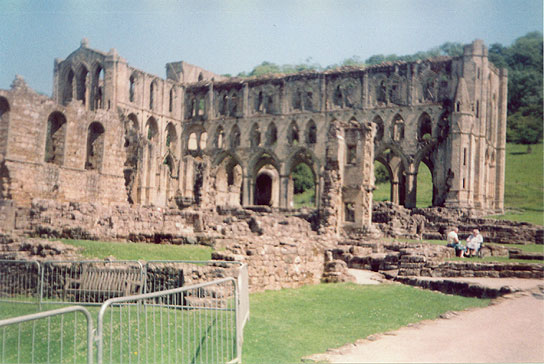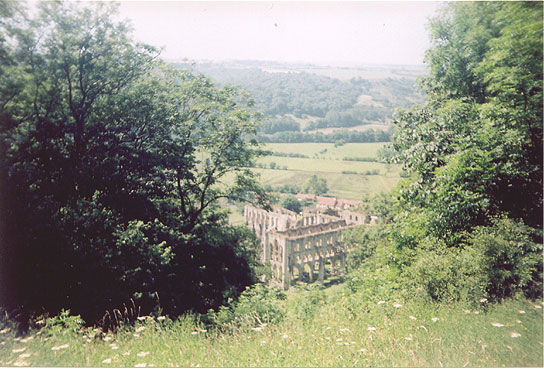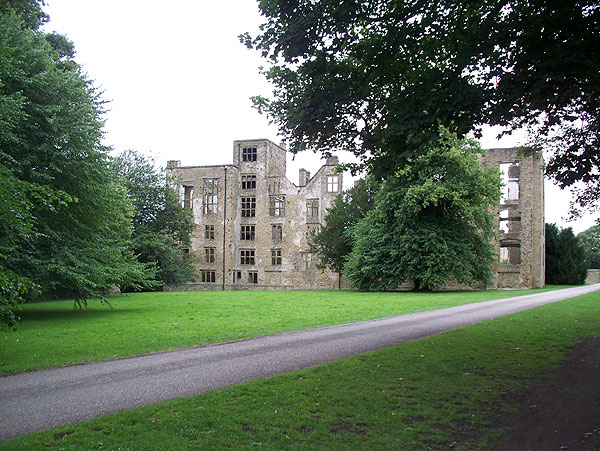English Heritage.
One of the iconic English monuments. It is easily found at the A303/A344 junction and you could make it a stop en route to the south-west. There have been plans to expensively re-work the surroundings and visitor access, but when I visited in 2007, one had to park across the road from the stones in the EH car-park, and then cross under the road via a tunnel. One could walk around the stones in a circle but not walk amongst them. The site is open daily. (Admission charge) A free audio tour is available.
Druid myths apart, the site is impressive, the standing stones are colossal and the prehistoric workmanship amazing. A number of fallen and unstable stones were re-erected in the 20th century to restore the circle to more like its ancient complete form.
The ancient monument enthusiast will find other monuments in the same area.
Category: Ruin
ruins of all kinds
Chysauster Ancient Village, Cornwall
English Heritage.
This Iron Age settlement was originally occupied almost 2,000 years ago. The village consisted of stone-walled homesteads known as ‘courtyard houses’, found only on the Land’s End peninsula and the Isles of Scilly. The houses line a ‘village street’, and each had an open central courtyard surrounded by a number of thatched rooms.
There are also the remains of an enigmatic ‘fogou’ underground passage.
The site was presumably in use during the Roman occupation of Britain. Nine homesteads remain, with walls up to about four feet in height. The site is on a hill, with views of the surrounding country. If I remember correctly, access from the car park is by walking a footpath uphill along the side of a field.
Berry Pomeroy Castle, Devon
English Heritage.
The castle dates from the 15th century, and within the outer walls is a great 17th century Tudor mansion, now much ruined. The site is tucked away in a wooded valley, overlooking a steep drop. There is quite a lot to look at in the way of romantically ruined structures, and parts of the castle are quite well preserved. There is an audio tour. It’s worth a visit if you are in South Devon.
Berry Pomeroy Castle is one location where the satnav is less than helpful. If you enter the postcode into Google Maps, satellite view, you can see just why I found myself on the wrong road, going in the wrong direction, and a mile from the castle. I had to ask a local for directions. The roads in the vicinity are single track, with no visibility.
Whitby Abbey, Yorks
 English Heritage.
English Heritage.
The abbey stands on a headland overlooking the sea and the town of Whitby. The Gothic ruins are said to have inspired Bram Stoker when he was writing ‘Dracula’. The site dates from AD 657, and the visible ruins, in an Early English gothic style, date from the 13th century. Quite a lot of structure still stands, despite the ravages of time, North Sea weather, and a direct hit by a shell from a from a WWI German battle-cruiser. Also on the site are the remains of the Cholmley family mansion, now adapted to house the visitor centre and exhibitions. An audio tour is also available.
The Abbey can be reached from the town either by 199 steps, or by a much more circuitous motor route.
This is an iconic Gothic monument, and well worth a visit if you are visiting Whitby.
Rievaulx Abbey, Yorks.

The abbey ruins lie in a quiet valley and large parts of the church survive to their original height. There are substantial ruins of other monastery buildings. The site has yielded much archaeological evidence about abbey life, and there is an indoor exhibition. There is an audio tour.
Well worth a visit if you are touring in the area.
In theory, the site is overlooked by the nearby Rievaulx Terrace above, but in practice the view (in 2005) is severly restricted by tree growth.

Pickering Castle, Yorks.
English Heritage
An interesting castle built on top of a mound surrouded by a deep ditch, obviously a replacement for a Norman wooden + earthwork fortification. Much remains of the outer circuit of walls surrounding the ditch, but not so much of the stone keep. There are views from the top of the mound.
Worth a visit if you are touring in the area.
Mount Grace Priory, Yorks.
English Heritage
In a grassy space are substantial ruins of the small priory church, and of the four-room cells inhabited by the monks. One of the cells has been restored and furnished to show how the monks lived. Each Carthusian monk mostly lived alone in his cell, to which meals were brought. Each cell had its own garden, and its own running water and primitive toilet.
An interesting site, worth a visit if you are in the area.
Helmsley Castle, Yorks.
English Heritage.
The castle, originally a medaeval fortress, later acquired a luxurious Tudor house within its walls. The castle was rendered unusable at the end of the Civil War. Later still, it was regarded as a Victorian romantic ruin.
Today, the circuit of walls is largely intact. Inside is a wide area of grassy lawn. The visitor enters via a gatehouse and can look at the half of the keep still standing, the other half having been blown up and allowed to fall into the moat. The Tudor residence is now used as an exhibition space. An audio guide is available.
The castle is definitely worth a visit if you are in the area. Other EH properties are nearby.
Hardwick Old Hall, Derbyshire
 English Heritage
English Heritage
The old hall was remodelled by Elisabeth Shrewsbury before she had the new hall built. The roofless ruins still stand to almost their original height, and visitors can ascend four floors to view surviving decorative plasterwork. Kitchens and service rooms are also visible. The house was partly dismantled in the 1750’s. An audio tour is available, and there is an exhibition in the West Lodge describing Bess’s adventures in architecture.
Fountains Abbey, Yorks.
National Trust & English Heritage
Fountains Abbey is now rated as a World Heritage Site. The abbey ruins are unusually complete, with many parts standing at near their original height. Perhaps the site was too remote to be extensively pillaged for building stone. There is much to see and do on site. Besides exploring the extensive abbey ruins, you can explore the beautifully landscaped Georgian water garden of Studley Royal, and visit Elizabethan Fountains Hall, the Cistercian monastery corn mill, and St Mary’s Church.
The gardens have a lake and many temples and follies, and even a twisting tunnel designed to give visitors a mild scare. If you are a fan of William Burges, do not miss the Victorian church, which looks plain on the outside, but inside is a riot of Victorian Gothic colour and carved ornamentation in wood and stone.
You should plan for an all-day visit.
